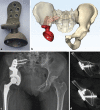Surgical applications of three-dimensional printing in the pelvis and acetabulum: from models and tools to implants
- PMID: 30887060
- PMCID: PMC6447520
- DOI: 10.1007/s00113-019-0626-8
Surgical applications of three-dimensional printing in the pelvis and acetabulum: from models and tools to implants
Abstract
There are numerous orthopaedic applications of three-dimensional (3D) printing for the pelvis and acetabulum. The authors reviewed recently published articles and summarized their experience. 3D printed anatomical models are particularly useful in pelvic and acetabular fracture surgery for planning, implant templating and for anatomical assessment of pathologies such as CAM-type femoroacetabular impingement and rare deformities. Custom-made metal 3D printed patient-specific implants and instruments are increasingly being studied for pelvic oncologic resection and reconstruction of resected defects as well as for revision hip arthroplasties with favourable results. This article also discusses cost-effectiveness considerations when preparing pelvic 3D printed models from a hospital 3D printing centre.
Es gibt zahlreiche orthopädische Anwendungen des 3‑dimensionalen (3‑D) Drucks für Becken und Acetabulum. Im vorliegenden Beitrag werden in jüngerer Zeit publizierte Beiträge und eigene Erfahrungen zusammengefasst. Mittels 3‑D-Druck erstellte anatomische Modelle sind in der operativen Versorgung von Becken- und Acetabulumfrakturen besonders nützlich für die Planung, das Implantat-Templating und die anatomische Abklärung von Krankheitsbildern wie dem femoroacetabulären Cam-Impingement und seltenen Deformitäten. Mittels 3‑D-Druck maßgeschneiderte, patientenspezifische Metallimplantate und Instrumente werden vermehrt im Rahmen der onkologischen Beckenresektion und nachfolgenden Rekonstruktion von Defekten sowie in der Revisionsendoprothetik an der Hüfte getestet; die Ergebnisse sind positiv. Im vorliegenden Beitrag wird auch die Wirtschaftlichkeit diskutiert, wenn Beckenmodelle in einem innerklinischen Zentrum für 3‑D-Druck hergestellt werden.
Keywords: 3D printing; Hip replacement; Orthopaedics; Pelvic tumour; Pelvis.
Conflict of interest statement
C. Fang is co-founder of Lifespans Ltd. H. Cai serves as a paid consultant to AK Medical and Koln 3D Medical Technology. E. Kuong, E. Chui, Y.C. Siu, T. Ji and I. Drstvenšek declare that they have no competing interests.
Figures







References
Publication types
MeSH terms
LinkOut - more resources
Full Text Sources

